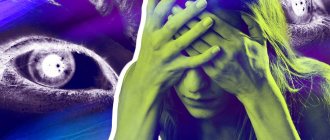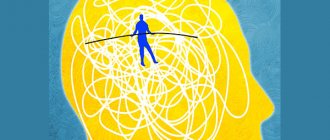Medical information is reliable Checked by Shaidullin Renat Flyurovich
Schizophrenia is a mental disorder characterized by disturbances in the emotional-volitional sphere and pathology of thought processes. Officially included in the international classification of diseases ICD-10 under the label F-20. It affects people regardless of age, gender and social status. In men it appears at an earlier age (18-25 years), while in women it first develops between 26 and 45 years.
During periods of exacerbation, a sick person must be under the supervision of a specialist. In this case, he will be provided with assistance to overcome the crisis in the most delicate manner. We provide anonymous support and keep the information of the patient and his relatives confidential.
Signs of schizophrenia
Official medicine finds it difficult to determine the exact causes that cause the development of schizophrenia. Long-term study of the mechanisms of the disease has not made it possible to identify specific stimuli for the deterioration of mental health. Somatic manifestations of the disease in childhood, adulthood and adolescence have significant differences. Therefore, a final diagnosis is possible only during the onset of puberty.
Among the most likely prerequisites for the development of a mental disorder, there are several main ones.
- Genetic predisposition.
The disease can be inherited from a close relative; approximately 10% of children in adolescence are diagnosed with this diagnosis if their mother or father has it.
- Hormonal dysfunction.
Schizophrenia is associated with impaired dopamine production. This hormone is a neurotransmitter that is responsible for the state of a person’s emotional sphere. If there is a pathology of the central nervous system, dopamine is produced in excess. At the physiological level, this causes intense mental overexcitation, in which a person constantly remains. The result is delusions, paranoid ideas, obsession, psychosis or hallucinations.
- The impact of viruses on the human body.
There is a category of pathogenic microorganisms that can destroy nerve cells. One of the most known pathological agents to science is the herpes virus. With good immunity, it can stay in the body for years without causing harm. If the patient suffers from various diseases of a chronic or infectious nature, viruses can manifest themselves, causing the manifestation of schizophrenia.
- Toxoplasmosis.
This is an indirect cause of the development of schizophrenia, but rather one of the risk factors. It is especially dangerous if a pregnant woman is infected: the fetus can develop pathologies, including diseases of the nervous system.
Common causes of schizophrenia include:
- alcohol, drug and other types of addiction;
- pathologies of intrauterine development;
- brain injuries that occurred during childbirth or throughout life;
- heredity;
- severe emotional shock;
- prolonged stay in a state of stress, prolonged depression.
Scientists believe that specific family attitudes are also the trigger for the development of the disease. Parents force the child to react to certain situations according to one scenario, while they themselves perform completely different actions. The dualistic attitude cannot be analyzed by a small child due to his age. Contradictions grow inside him, with which he is left alone. The constant search for answers to one's questions causes intrapersonal conflict, which over time can develop into a mental disorder.
Schizophrenia is not a death sentence
Many patients, having learned about their diagnosis, give up on themselves, their dreams and goals, believing that it is impossible to live fully.
This is a big misconception. There are many examples where people, living “in collaboration” with their illness, achieve much more than the average person.
Law professor Elin Sachs has lived hand in hand with schizophrenia for 30 years.
The first attack happened to her at the age of 16, when she was returning home from school. The houses around her became somehow animated, giving her verbal signals. Psychotic episodes then recurred at university. She was suddenly overcome by speech nonsense: Conclusion presupposes presence. And that’s the whole point. Salt is on the nightstand. Sam spoke. Did you kill someone?
She was visited by delusional thoughts about the fact that she had killed many people, she was visited by frightening hallucinations, her thoughts were confused and incoherent. Elin characterized this period as a nightmare, but she was unable to wake up. She was terrified and confused. But classical methods of therapy helped her: a psychoanalytic approach and drug treatment.
Her relationship with medications did not improve right away. For the time being, Ellin believed that the fewer medications, the better. Her therapist tried to convince her otherwise, but she wouldn't budge. She reduced the dosage until, during her next visit to a psychotherapist, she fell on the floor and began to thrash convulsively against it. It seemed to her that strange creatures with knives were attacking her and cutting her into small pieces. As a result, she nevertheless returned to the prescribed medications, and has not parted with them to this day.
When Ellin once again began to talk nonsense in the psychiatrist’s office, he offered her hospitalization, which she had to agree to.
Elin is currently a professor at the University of South Carolina School of Law and a member of the Department of Psychiatry at the University of California, San Diego. In the past, despite her illness, she received a fellowship from the MacArthur Foundation, one of the most prestigious philanthropic organizations. The disorder did not prevent her from successfully getting married at the age of 40.
Her case proves that schizophrenia is not a reason to isolate yourself from the world, including yourself. The disease can be kept under control, you just need to work on yourself.
With her colleagues, Elin conducts research on schizophrenia. They were able to study 20 people who also live with the disease. Most of them have been through more than one hospitalization, most have a diploma of higher or secondary education. Among them are masters, psychologists and lawyers, doctors, technologists and managers, and the general director. They all live an active life and are not used to being discouraged.
Prerequisites for the development of schizophrenia in childhood
The psyche of a small child is very vulnerable; his condition and mood largely depend on the people around him and the events taking place around him. The psychological perception of reality is established at an early age. If a deviation of the schizoid type is observed, doctors do not undertake to make a definitive diagnosis; they recommend waiting until adolescence.
The tendency to the disease in preschool age manifests itself specifically:
- the child is considered strange - he reacts inappropriately to events;
- often experiences unreasonable fear;
- becomes overly irritable and impulsive;
- when observing him, increased nervous excitability appears;
- bouts of crying that occur for no particular reason can last a long time;
- the child often moves from euphoria to apathy;
- he talks about his visions, hallucinations;
- the teenager is bothered by obsessive thoughts, he gets fixated on the same idea.
If there are several such negative manifestations, there is reason to think about visiting a psychiatrist. Deviations may be accompanied by personality degradation, which will fully manifest itself in adolescence. This may include dissatisfaction with appearance, delusions and hallucinations, motor dysfunction, suicidal thoughts and attempts to die.
Treatment of schizophrenia at home
If you notice disturbing symptoms of schizophrenia in one of your loved ones, then you should not try to treat him yourself. Without the use of special medications, the disease will progress rapidly, which will lead to complete degradation of the personality of the sick person. Be sure to contact a specialized medical institution for qualified help.
There is no need to fear that a person close to you will forever be labeled “psycho.” Today, treatment of people with mental problems is carried out in complete confidentiality, and being in a hospital can be compared to relaxing in a boarding house. Modern clinics create comfortable conditions that promote the speedy recovery of mentally ill people.
Treatment of schizophrenia at home is possible if the patient has undergone intensive therapy in a hospital. Once his condition has stabilized, the doctor may prescribe a course of treatment that can be done at home. In addition to taking medications and visiting a psychotherapist, restorative therapy includes:
- Normalization of nutrition. During attacks of the disease, a schizophrenic experiences severe nervous tension, as a result of which he sharply loses weight. To fight the disease you need to have strength, and for this you need to eat well. The daily diet should include healthy foods that allow the body to receive everything it needs for normal functioning.
- Full sleep. Every person needs to get enough sleep, because this is the only way the nervous system can rest. It is generally accepted that you need to sleep 8 hours a day, but for some of us 5-6 hours is enough, while others may need 12 hours. Therefore, you need to sleep as much as your nervous system needs to recover. People with schizophrenia often have trouble falling asleep. They may be tormented by nightmares or simply feel sorry for wasting time because they have so many “brilliant” ideas. But you need to sleep, so you can take medications to help you sleep.
- Yoga classes will be useful. But the exercises must be performed under the guidance of a trainer in the absence of contraindications.
- Playing sports will help restore the nervous system. People suffering from schizophrenia are best suited to visiting a swimming pool. Water calms the nervous system and helps the body relax. Relaxing agents include sunlight and fresh air. By combining all these components you can achieve good results. But do not forget about the safety rules while sunbathing and air bathing, as well as when visiting the pool.
Treatment for schizophrenia is primarily aimed at helping the person regain control of their mind. A psychotherapist can teach the patient appropriate techniques, but success largely depends on the person himself. An individual suffering from a mild form of schizophrenia can help himself through willpower, but in severe cases this is almost impossible.
Schizophrenia symptoms
The signs of the disease are clearly indicated by doctors. All symptoms of schizophrenia are divided into 4 large groups:
- positive;
- negative;
- disorganized;
- affective.
Positive symptoms
Positive signs of schizophrenia were not previously inherent in the patient, are not specific traits of his character, and arise exclusively against the background of the disease. The term “positive” implies the emergence of new qualities, in this case it is not used as “good”. This group of symptoms includes:
- inappropriate reactions to people and events;
- constantly excited state;
- delusions, illusions, hallucinations.
Inappropriate behavior is expressed in the form of stupid actions, excessive nervousness, inconsistency of manners and appearance of a certain situation. This category includes two types of mental disorders - depersonalization and derealization. The first represents a violation of internal boundaries: a person’s personality seems to be split into two parts. One of them performs certain actions, the second watches them and cannot interfere. The body and thoughts seem foreign to a person, as if someone else had settled inside him. This “tenant” dictates his own rules, indicates the need to perform certain actions.
Derealization is characterized by increased perception of various factors (sounds, smells, shades). It seems to a person that everything that happens has no connection with reality, this is a kind of theater in which each “actor” plays his own role.
Catatonia is considered one of the variants of inappropriate behavior in schizophrenia. The person falls into a stupor, takes an awkward position and remains in it for a very long time. Any attempts from the outside to bring him out of this state are doomed to failure. Schizophrenics have great muscle strength and are able to successfully resist.
Hebephrenia is also a type of inappropriate behavior. Regardless of where the patient is, he behaves stupidly, constantly laughs, fools around, jumps on the spot, makes grimaces. Discussions about the inappropriateness of such behavior lead nowhere. Attempts to appeal to conscience end in failure.
Hallucinations are a complex of sensations of a specific nature that do not really exist. They are inextricably linked with the human senses and are divided into gustatory, visual, olfactory, tactile and auditory. In schizophrenia, the patient most often suffers from auditory hallucinations. In the surrounding space or in his own head, he hears voices conducting a coherent conversation with him. They can give commands, which the schizophrenic often obeys, to calm or make people laugh. Hallucinations lead to the development of delusional ideas. A schizophrenic is absolutely sure that everything that happens to him is real, and his loved ones deceive him for an unknown purpose.
Negative symptoms
The category of negative symptoms in schizophrenia characterizes signs that have disappeared or changed their functions. If before the onset of the disease a person’s character had certain traits and qualities, after the manifestation of the disease they either disappear completely or become less pronounced.
This category includes:
- loss of vital energy, motivation to act;
- lack of initiative in everyday and professional matters;
- physical passivity;
- decreased thinking functions, impaired cognitive processes;
- narrowing the range of interests;
- emotional poverty, apathy, indifference to what is happening;
- movements become sluggish and sluggish;
- self-control is weak or absent;
- the patient cannot construct an algorithm of sequential actions;
- he is unable to derive pleasure from external stimuli.
Lack of motivation for everything leads to personality degradation (similar symptoms are observed during the treatment of Pick's disease). Schizophrenics strive for social isolation, they often do not leave the house, and neglect the rules of personal hygiene. Their appearance becomes sloppy, which alienates others. You can understand that a person has schizophrenia by the following features of his speech:
- he constantly jumps from one topic to another, interrupts himself, constructs an incoherent speech;
- uses new, often awkward words that he comes up with;
- repeatedly repeats individual phrases and sentences after others;
- speech becomes rapid and incoherent;
- begins to speak in rhyme;
- answers to questions are monosyllabic, incomplete or unclear;
- in the absence of thoughts, he suddenly withdraws into himself, stopping the conversation.
Often in schizophrenics, thinking disorder is expressed in reasoning. A person constantly talks about topics he has come up with, even if they try to involve him in another conversation or interrupt him, he does not react to this.
Disorganized symptoms present difficulties with spatial orientation. These include chaotic behavior, problems with thinking and impaired speech functions. Affective symptoms are expressed in a constantly depressed mood. Schizophrenics are often depressed and try to get out of this state on their own by starting to use alcohol or psychotropic substances. They are visited by suicidal thoughts, which can be realized at one moment. The patient often blames himself for everything, even if he has nothing to do with what is happening.
Reasons for development
Schizophrenia, like other mental disorders, occurs due to dysfunction of the central nervous system. A malfunction occurs in certain brain structures, which leads to disruption of neural connections. They are not destroyed at all, just the commands given to the central nervous system become “incorrect”.
To date, there is no reliable information about why exactly schizophrenia develops. Most researchers believe that this disorder is hereditary. That is, the presence of people with schizophrenia in a family several times increases the likelihood of developing the disease in other family members. But so far no one has been able to identify a single “schizophrenia gene.” Most likely, there is some gene combination that makes a person vulnerable to this disorder, but does not necessarily cause it. A combination of various factors plays a major role: a person’s environment, genetics, individual characteristics of the body, etc.
Sometimes you can come across statements that a person has gone crazy from severe stress. But psychological trauma does not lead to schizophrenia; it can only give impetus to the development of the disease, if a person has such a predisposition.
The first signs of schizophrenia can be detected at different ages, but in a larger number of patients this disorder began to develop between the ages of 16 and 25 years. This period accounts for the greatest psycho-emotional load associated with adolescence in adolescence, first love, puberty and hormonal changes. All this also provokes the development of mental illnesses, to which a person has a predisposition.
Scientists also have not found a relationship between the likelihood of developing schizophrenia and belonging to a particular race, nationality, gender, etc.
The prevalence of this disorder is approximately the same throughout the world, affecting approximately 1% of the world's population.
Schizophrenia symptoms and signs in women
At an early stage of the disease, the first symptoms in women manifest themselves in the form of hallucinations and delusions. The emotional background becomes unstable, depression and apathy arise towards everything that previously aroused interest. These signs may remain the only ones and exist for several years until productive symptoms appear. Patients and their relatives have no idea that the disease has already taken root.
Patients become unfriendly, strive for social isolation, avoid contacts, and often become irritated over trifles. The woman’s manner of speaking changes dramatically. She cannot explain to others what she wants to convey to them or limits herself to short phrases and takes a long time to select the right words.
Women with this diagnosis feel like they are being influenced by hypnosis, they can hear the voices of aliens, and often see pictures and even entire films in their heads. Patients complain of a shooting sensation, burning or drilling in the brain.
The feeling of attachment to loved ones and children is lost, the patient treats them as strangers. Women are more likely than men to be interested in magic and otherworldly forces. Therefore, they perceive their condition as the emergence of magical possibilities or the influence of magicians and sorcerers on themselves.
Diagnostics
According to statistics, the disease manifests itself most often in adolescence. If there are certain triggers, you can feel the disease at a fairly young age. The onset of schizophrenia is usually observed before the age of 30–35 years.
Prussian psychosis
As noted above, the first symptoms of the disease appear at a young age; schizophrenic disorder does not appear in the second half of life. Acute psychosis in elderly patients is classified in psychiatry as “cyanotic psychosis” rather than schizophrenia. However, its symptoms are quite similar to those of schizophrenia. Hallucinations and delusions may occur. But, most likely, they will be of a vascular nature: vascular dementia, brain destruction (Alzheimer’s, Parkinson’s or Pick’s disease). In any case, such organic brain lesions are not related to schizophrenia. Quite often, the differential diagnosis of schizophrenia causes significant difficulties. This is especially true for the initial stage of the disease or periods of deep remission, as well as when one person combines alcoholism and schizophrenia or has suffered psychotrauma against which pathology has developed. Thus, within the framework of the differential method, it is quite difficult to determine the disease on your own. As noted above, not every symptom characterizes this particular disorder. But a person cannot suspect schizophrenia in himself, since this is associated with a loss of criticism.
He may, for example, discover depression or neurosis and, in connection with them, go to a specialist, who, in turn, should conduct a more detailed study and prescribe medication. But, unfortunately, the disease is often noticed by the patient’s relatives at fairly late stages and they are hospitalized in an acute condition, because advanced symptoms are most often interpreted as coincidences or coincidences, or as a consequence of stress or neurosis. Thus, everyone expects that they will go away on their own, and if they take medications, they are more likely of homeopathic or herbal origin, which do not cure the disease, but simply help to prolong it. Thus, due to incorrect diagnosis and late diagnosis, schizophrenic psychosis most often debuts in the patient in an acute form.
Differential diagnosis of the disorder
An important stage of diagnosis is the differentiation of a schizophrenic attack from a neurotic or other mental disorder, as well as the rejection of diseases of an infectious nature that have a destructive effect on neural connections.
For example, an acute psychosis or manic episode, also identified as a polymorphonic psychotic disorder, can also unfold against the background of other diseases, for example, within the framework of schizoaffective or bipolar disorder, which can serve as precursors, but in general are not related to schizophrenia, since they are to another cluster of diseases, a cluster of mood disorders. Bipolar affective disorder, for example, has a more favorable prognosis for life and work. However, even an experienced specialist can sometimes confuse the state of acute psychosis in a neurotic or other disorder with a schizophrenic coat (schizophrenic psychosis). That is why it is very important to observe a person with a team of specialists and in dynamics. The patient’s condition after recovery from acute psychosis is of great importance, since only the stagnation phase makes it possible to more clearly differentiate schizophrenia from other mental disorders.
Schizophrenia signs and symptoms in men
Symptoms of the disease in males are very similar to those in women. In the first stage, they experience discomfort due to hallucinations and delusional ideas. There is degradation of personality and loss of human appearance in the truest sense of the word.
A person becomes sloppy, stops washing and brushing his teeth, and eventually decides not to leave the house. The man has pronounced aggression and an increased level of anxiety. Sometimes this state can turn into panic, which is a concomitant symptom of depersonalization. The patient has a thinking disorder and various motor disorders.
Special forms of schizophrenia
Special forms of the disease imply its intensive development. Most often, a patient comes to the hospital and first comes to the attention of a psychiatrist in the acute form of the disorder (acute psychosis). In such a situation, a person’s behavior changes, he behaves aggressively and can be dangerous to himself and others, he can express various delusional, paranoid ideas that are completely unrelated to reality, and also hallucinate profusely: these can be visual and auditory hallucinations that visible from the side with the naked eye. It’s impossible not to notice this anymore.
Special forms are classified as: hebephrenic, catonic, paranoid and febrile. Let's talk about them.
Hebephrenic form
This type is characterized by a state of passion and emotional disorder. The first symptoms usually appear during adolescence. The patient’s behavior becomes extremely strange, one might say feigned, inappropriate to the situation, and sometimes mannered. Positive signs of the disease (hallucinosis and forms of delirium) are not so noticeable, but negative symptoms (social isolation and problems and destruction of adaptation) quickly develop. The prognosis is most often unfavorable, as it is one of the most progressive forms.
Catonic form
Mostly, the clinical picture is characterized by various disturbances in the patient’s movements, differing in polarity, in other words, periods of exaltation (hyperactivity) can be replaced by numbness or catatonia (stupor). The patient may remain in stupor for quite a long time (up to several days), and then suddenly fall into exaltation. It is in this form that such a symptom as the “look of a schizophrenic” clearly manifests itself. The patient has a strange look, frightened, inadequate, sometimes glassy, staring at one point. However, the prognosis in this case is more favorable and depends on the combination of positive and negative symptoms.
Paranoid form
One of the constitutive signs of this form is paranoid delusion. There are a huge number of types of delusions: delusions of persecution, delusions of threat, delusions of grandeur, etc. Often, the concepts of delusion can be combined with each other, for example, the patient believes that he is under dangerous surveillance because he is a millionaire or a popular person. Most often, delirium is accompanied by hallucinosis.
Febrile form
In the history of febrile form, disturbances are observed at the body level, for example, an increase in temperature up to 39 degrees Celsius, the distinctive feature of which is the lack of response to antipyretic drugs. Also, it is worth paying attention to the patient’s appearance: the skin becomes dry, redness or general redness is noticeable, tearing or an unhealthy shine in the eyes, etc. In relation to psychopathy, affectivity, feverish movements, aggression, up to clouding of consciousness and toxicoderma (violation of the integrity of the skin) are manifested. This is the most dangerous form, the mortality rate of which can reach 50%.
Stages of schizophrenia
Psychiatrists distinguish 3 stages of the development of the disease.
- Mastery
The initial stage, which is characterized by a constant feeling of anxiety. Most often, the patient does not understand where it came from. The occurrence of obsessive thoughts leads to the fact that the patient constantly checks whether he has turned off the gas, locked the apartment, and turned off the iron. With the help of timely drug therapy, unpleasant symptoms are eliminated.
- addictive
The middle stage of development of the disease, which is accompanied by changes in the personality and consciousness of the patient. The real or fictional world is intertwined with each other, a schizophrenic cannot understand where is truth and where is fiction. The feeling of fear goes away over time, the patient perceives the current state of affairs as a given. This stage requires immediate treatment in a hospital.
- Regression
This is a severe stage of the development of schizophrenia, during which profound changes in a person’s emotional background are observed. The patient does not react in any way to surrounding events and people; he loses feelings of joy, sadness, shame and pleasure. The condition resembles dementia or dementia in old age. Logical thinking is completely absent, speech and motor functions are impaired. This stage is difficult to treat; to maintain the patient’s vital functions, medications are used to restore neural connections in the brain.
Psychotherapy for schizophrenia
For a long time, treatment of schizophrenia was carried out only with medications. Psychotherapy was rarely used when working with this category of patients; it was only an auxiliary method, but today the situation is changing.
A psychotherapist with experience in this area is able to make his patient’s life fulfilling. To achieve this goal, work is carried out in several directions:
- Individual work with the patient. A sick person, with the help of a specialist, understands the essence of his disease. Learns to recognize factors that can trigger an exacerbation. Behavioral therapy helps to adjust the patient's behavior so that the risk of relapse is minimal.
- Working with relatives. Successful adaptation in society of a person with schizophrenia is impossible without the support of loved ones. The main feature of this disease is that a schizophrenic is forced to lead a secluded lifestyle; he cannot work, study or visit public places. Therefore, the main burden of adapting the patient falls on the shoulders of his environment. The faster and more successfully the adaptation period passes, the more favorable the prognosis will be and the lower the likelihood of developing exacerbations.
- Group therapy. During such meetings, patients share with each other their experience of fighting the disease, talk about their achievements and personal victories. This practice allows a sick person to accept his disease, not be afraid of it and not feel guilty for the development of the disease.
High-quality psychotherapy helps sick people live a normal life, but achieving such results is only possible with an integrated approach to the treatment of schizophrenia.
Sluggish schizophrenia
The diagnosis of sluggish schizophrenia is considered mild; it is a mild form of the disease. It does not imply critical changes in a person’s character and his brain. Clinical symptoms increase very slowly, and the patient exhibits a complex of signs of neurotic disorders. This form of the disease is characterized by obsessive-compulsive disorder, various phobias, hypochondria, and paranoia.
Common symptoms:
- autism;
- scarcity of interests;
- selfishness;
- difficulties in contacts with others;
- the occurrence of hysterical attacks against a background of increased anxiety;
- suspicion.
Patients often experience causeless pessimism, which has no basis in real life. Many psychotherapist patients talk about attacks of sentimentality that they had never had before, self-doubt, and various fears. Often this condition is attributed to nervous tension and stress, but in fact it is a hidden symptom of a mental disorder.
Myths about schizophrenia
Many myths have been created around schizophrenia, since this mental disorder scares people no less than AIDS or cancer. The most common misconceptions are the following:
1. All people suffering from schizophrenia are violent and dangerous, they belong in a special hospital. This myth is due to the fear of the unpredictability of mentally ill people in general and schizophrenics in particular. Cases of violence by the mentally ill receive too much publicity in the press, resulting in the impression that all “psychics” are dangerous.
In fact, people with schizophrenia are more likely to harm themselves than others. According to statistics, a much larger number of crimes are committed by persons under the influence of alcohol, but people who abuse alcohol are not isolated from society. Schizophrenics can lead completely normal lives if they follow the recommendations of their doctor.
2. The diagnosis of schizophrenia implies dementia and complete disability. It can be very difficult for people with various mental disorders to organize their own lives, but with the support of loved ones they can cope with the destructive influence of the disease. As for intellectual abilities, they are no higher or lower than those of healthy people.
Schizophrenia affects the way of thinking, not intellectual development. For example, John Forbes Nash Jr., who suffered from schizophrenia, learned to ignore his disorder. He became famous for receiving the Nobel Prize in Economics (1994). The film “A Beautiful Mind” was made about the life of this American mathematician.
3. Parents are to blame for the development of the disease. Modern research confirms that schizophrenia may be caused by heredity. However, genetic factors are not fundamental and the only ones that can influence the course of the disorder.
Its relationship with incorrect communication models in the family, pedagogical neglect and improper upbringing has not been established. Although an unfavorable environment can have a negative impact on the healing process, it cannot be considered the main cause of the development of schizophrenia.
4. Creative and brilliant people suffer from schizophrenia. Indeed, history contains many examples of great artists, poets and musicians suffering from various mental disorders. The artist Vincent Van Gogh and the writer N.V. Gogol were schizophrenics; it is attributed to Isaac Newton, Albert Einstein and other famous people. But the talents of these people have nothing to do with mental illness.
People with schizophrenia can demonstrate the same talents, strengths and weaknesses as a healthy person.
Another myth about schizophrenia is the persistent belief that this disorder does not need to be treated. It has already been mentioned several times above that schizophrenia cannot be treated. The point is that pathological changes in the human brain are irreversible. But modern medicine is able to help a sick person cope with the negative manifestations of schizophrenia, which can greatly complicate life for both himself and his loved ones.
Paranoid schizophrenia
This type of schizophrenia is characterized by distortions in thinking and perception. A striking feature, which is the basis for diagnosis, is the presence of delusions and hallucinations. The behavior of patients changes dramatically, they become suspicious, suspicious, aggressive and are constantly in a frightened state.
They are practically “switched off” from their usual life, stop taking care of themselves and performing any household duties. Lack of care from loved ones makes the situation worse. Treatment is long-term, and the prognosis for recovery in this form of schizophrenia is unpredictable. Patients with paranoid schizophrenia believe that they can transmit thoughts at a distance and hear voices. They believe that someone is trying to control them and force them to do different things, filling their minds with evil, pessimism and fear.
Symptoms of paranoid schizophrenia:
- real memories are joined by fictitious ones, a person receives a distorted picture of the past;
- appear beyond the idea;
- habitual behavior changes, it is far from the concept of adequacy;
- there are often nervous breakdowns and hysterics;
- patients are confident that they have a special mission, highly developed insight, intuition;
- are often in a state of anger, embitterment and gloom;
- meaningless thoughts begin the moment others ask them simple questions.
There are two forms of paranoid schizophrenia.
- Hallucinogenic.
Delusional disorder occurs chaotically and after some time disappears without a trace. Patients consider this state as an insight that helps them see their true purpose. This form of the disorder is easier to treat, the symptoms are completely controlled by medications. You can undergo a full course of therapy at Dr. Isaev’s Clinic.
- Delusional.
Fictional ideas of a fantastic nature arise spontaneously, the patient is often under their influence. This is a negative attitude towards loved ones, suspicion, mania of persecution, jealousy. This form takes on a continuous course; periods of remission are usually absent, which complicates the treatment process.
Pathologies of schizophrenia
Main psychopathic symptoms:
A feeling of “mirroring” thoughts (mental echo), detection of other people’s thoughts or loss of one’s own, replacement of thought processes, belief in the possibility of transmitting thoughts at a distance, delusions of various pathogenesis, asthenia, auditory, visual or verbal hallucinosis, affective suspicion, aggression and negativism. In some cases, a symptom of staging is very characteristic of the patient, for example, when a person says that some kind of performance is being played around him, all around people are hired actors, as if some action is taking place on stage, especially for him. A person experiences very vivid emotions: fear, anger, or, conversely, sexual disinhibition may be observed. Various bodily sensations may occur, such as a feeling of heat throughout the body or heat in the head.
Where is schizophrenia treated in Moscow?
At the acute stage, the patient should be in the hospital. In this state, he cannot control himself and his actions and requires round-the-clock care and the use of medications.
The Clinic of Dr. Isaev treats schizophrenia using safe, licensed drugs. The disease goes into remission, he can continue to live normally and take care of himself on his own.
Problems in the treatment of schizophrenia
As a rule, the disease attracts attention when productive symptoms appear. Let us remember that these include, first of all, delusions and hallucinations, as well as fragmented thinking and incoherence of speech.
Hallucinations are most often vocal. They force the patient to perform certain actions, sometimes of a negative nature. Hallucinations lead a person to engage in unlawful actions or to threaten themselves and others.
Delusions of jealousy and persecution are common among delusional ideas. Sometimes the statements of such patients are so plausible that it is very difficult to believe that they are not truthful.
The fragmentation of thinking is manifested by incoherence of statements. Here is an example of a dialogue with a girl with schizophrenia:
— My mother has a neurological disability, and this is already cobalt.
- Nastya, what kind of cobalt, metal, or what?
— Metal is not metal, but this is already the ceiling.
The disease also has other signs related to negative symptoms: apathy, lack of will, alienation, etc. But in isolated form they rarely suggest a schizophrenic disorder.
So, the patient is admitted to the hospital in the acute period of the disease with delusional speech, reinforced by unrealistic images and with a violation of self-identification. Medications help relieve exacerbation. They are the first medical aid in such a situation, stabilizing the patient’s condition.
But this is not the end of taking medications. The patient faces a long period of drug treatment. The first means of treatment for schizophrenia are antipsychotics, which eliminate psychopositive symptoms, as well as antidepressants and other antipsychotic drugs.
It is with the use of such drugs that some problems are associated that delay the onset of remission.
Firstly, it happens that you have to try several treatment regimens and try more than one drug before you can achieve the desired results. Antipsychotic drugs are quite effective in dealing with hallucinations (they disappear after a couple of days), and with delusional ideas, which take several weeks to resolve. In general, it takes up to 6 weeks for the patient’s condition to normalize.
Secondly, side effects often occur while taking antipsychotic drugs. This may include dizziness, drowsiness, visual disturbances, tachycardia, photosensitivity. They usually go away within a few weeks.
More serious consequences include seizures, weight gain, and heart attacks.
Since schizophrenia is a chronic disease, a person has to take such medications throughout his life. If you stop taking them on your own, the psychotic episodes will recur. The decision to discontinue medications should be made only by a doctor after adjusting the treatment.
It should be noted that the doctor should listen to the feelings expressed by the patient about taking antipsychotics. In case of intolerance, he will try to choose a more suitable remedy.
Unfortunately, many patients do not understand the seriousness of the situation and refuse to take medications. The reasons for this may be different:
- disbelief in the existence of the disease;
- duration of treatment;
- severity of side effects;
- lack of quick results;
- disorganized thinking when the patient simply forgets to take a pill.
Drug therapy is the main step towards successful treatment of the disorder. It is necessary to convey to the patient the seriousness and necessity of using medications. Experts are developing new ways to make them easier to take.
One of these ways was the emergence of a new generation of antipsychotics. They significantly reduce the severity of side effects, which is why they are much better tolerated by patients. Among them there are drugs that are prolonged, that is, long-acting. They don't need to be used every day. Just a few doses per week are enough.
In addition, there are injections that also replace the daily “swallowing” of pills.
As a reminder for such patients, special medical calendars have been developed, which indicate the days of taking medications, as well as organizer boxes in which medications are laid out according to the days of use. This is not only convenient for the patients themselves, but also for their relatives who supervise the treatment.
A common reminder method is also an electronic timer, signaling that it is time to take your medicine.
Here is the story of a woman who tells the story of her husband's development of the disorder. For her it became a real hell. From a caring and kind husband, he turned into an aggressive and rude paranoid: he broke phones and laptops, claiming that the FSB was listening to him, and for him his neighbors were nothing more than agents. The man claimed that his wife was possessed by demons and aliens. He didn't sleep at night, wandering around the rooms, talking and laughing to himself.
The disease accompanied him for several years. The symptoms worsened when he stopped taking the pills. Once again the woman tried to convince her husband of the advisability of taking them. He completed the full course, lasting a year, and achieved stable remission.
Stories like this once again prove the need to take antipsychotic drugs. It's time to understand that for schizophrenia they are the same mandatory medicine as insulin for diabetes.
Questions and answers
Can schizophrenia be treated with tranquilizers or antidepressants?
Mental disorder is treated exclusively in a hospital setting. Such drugs are prescribed by the doctor after a thorough examination of the patient.
Does treatment for schizophrenia lead to complete recovery?
Schizophrenia is an incurable disease. It is possible to achieve a long stage of remission, during which time the patient is able to return to normal life.
Does the patient understand that he is sick?
This is not always the case. He takes delusional ideas and hallucinations for reality. In moments of “enlightenment” he may understand that he has disturbances in the emotional-volitional sphere. This occurs at the first or second stage of pathology development.
Etiology of the disease schizophrenia
Despite many studies conducted in this direction, the exact cause of the disease is not completely clear. In psychiatry, it is generally accepted that hereditary predisposition plays a key role.
But the “impetus” for the manifestation of pathology can be:
- stress factors;
- injuries;
- unfavorable psychological atmosphere in the family;
- severe infections (the exact mechanism of development of the pathology is unknown, but it has been established that more often it occurs after a viral illness);
- consumption of alcohol, drugs.
Types of schizophrenia
Species gradation is carried out according to the severity of symptoms and stage of development. The disorder usually begins with a simple (weak) sluggish form. A sluggish or poorly progressive form implies a stable course of the disease with mild symptoms. There are no acute sudden attacks. A diagnosis can only be made based on indirect clinical signs, which are sometimes quite difficult to distinguish from ordinary neurotic symptoms.
Progressive - includes two more types of disease: paroxysmal and continuous. The debut occurs after 25 years, but in certain cases the pathology can manifest itself earlier. In this subtype, the disease develops slowly and gradually, but the attacks themselves can be very acute, or the primary symptoms are pronounced.
Continuous flow
It is a complex concept that combines several forms. Moreover, the influence of environmental factors (endogenous) in this case is minimal. The destruction process itself begins extremely gradually, but remissions, as such, are practically absent. Sometimes the symptoms become less noticeable, but they never completely disappear.
Paroxysmal course
Or, as they also say, acute polymorphic disorder progresses over a couple of days, and then can last up to several weeks. Key symptoms: sleep disorder, anxiety, deconcentration, general extreme emotional lability, for example, causeless phobias (attacks of fear) are replaced by euphoric affect, joy and laughter alternate with crying and complaints. From time to time, patients with schizophrenia experience hallucinations and pseudohallucinations: voices sound in the patients’ heads, or they can sort through things, mutter something under their breath, and make secret notes.
Treatment and prevention of schizophrenia
Treatment of schizophrenia is a rather difficult task, since it can take years to destroy the structure of delusion in the patient’s brain, and moreover, complete healing is impossible to achieve. It’s good if a person becomes aware of his condition, but most often this also does not happen.
A diagnosis of schizophrenia in itself does not entail any consequences. At the initial stage, this is most likely only registration at a dispensary at the place of residence, and then only if the person is taken by ambulance to a city hospital of municipal subordination.
In general, a schizophrenic during periods of remission is not particularly different from an ordinary person, he behaves and speaks normally, he can work, for example, and communicate in deficit states (a period of remission, not acute psychosis).
Many people ask the question: Is hospital treatment necessary?
Each case of the disease is individual, but in general, with a favorable prognosis, it can be treated on an outpatient basis, that is, inpatient treatment is not required.
It is necessary to register with the dispensary and check in at certain intervals, but in the future the person has the right to withdraw from this registration. It all depends on the prognosis, which is different for everyone. The underlying factor depends on the specific course of the disease. As discussed above, the course can be continuous, paroxysmal, and even episodic. The episodic course is the mildest form, in which psychosis occurs very rarely, and in principle a person can suffer from schizophrenia, but continue to work and have a family. In such cases, drug therapy is used, which significantly reduces the possibility of developing an attack.
There are also modern treatment methods and drugs that do not cause serious side effects and give a good prognosis for the future. Unfortunately, the patient can take these medications for the rest of his life, which provide a reasonable quality of life.
Thus, the diagnosis of “schizophrenia” is not a death sentence, just like diabetes mellitus or bronchial asthma. Moreover, schizophrenia is not fatal. The lethal outcome is minimal, with the exception of possible suicide during psychosis.
Progressive form of schizophrenia and treatment
The progressive form implies the absence of a positive effect from treatment. In other words, a person is treated for a long time and unsuccessfully, since psychoses continue to recur. In this case, so-called anti-resistant methods are used, including both medicinal and non-medicinal methods of treatment.
Medicinal methods
This is taking certain medications in accordance with a regimen developed by a psychiatrist, which helps relieve resistance. Resistance is understood as a decrease in the pharmacological effect of a drug in a patient, which leads to a decrease in the effectiveness of treatment. Thus, if drug therapy does not produce results, then the next step is hardware methods.
Apparatus therapy
transcranial magnetic stimulation of the brain and electroconvulsive therapy. Impact on brain neurons using currents and magnetic fields. Previously, atropine comas and insulin comatose therapy were also used. very expensive material. Insulin treatment, by the way, is a very good method, but incredibly expensive to use. In the USA and Europe, electroconvulsive therapy is quite popular at this stage. It is worth noting that this particular method was stigmatized for many years, as it was recognized as inhumane, but now this type of treatment is carried out under general anesthesia. The patient does not experience any suffering, and the effect is positive due to the fact that there is a direct effect on the blood vessels of the brain, the permeability of the blood-brain barrier increases, and thus the drugs quickly and effectively reach the receptors. Also, this method is often used before prescribing medications if the patient is admitted in psychosis, allowing the psychotic state to be stopped independently.
Psychotherapy
Throughout life, when treating and stopping the disease, it is necessary to take into account all factors: biological, psychological and social. Implementation of biopsychosocial surveillance is possible only under the close supervision of a team of specialists, including a psychiatrist, psychotherapist, and clinical psychologist. Working with such patients must be done very carefully. In this aspect, positive psychotherapy is ideal within the framework of the Self - a concept where the patient works with and addresses his healthy part. Another important point in treatment is socialization, since the symptoms of the disease affect the everyday areas of the patient’s life. Literally speaking, an encounter with aliens or Napoleon should not interfere with brushing your teeth, washing clothes, maintaining a routine, and performing other everyday tasks.











